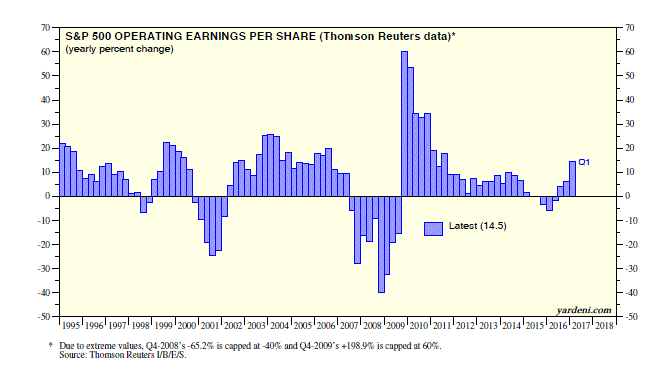Q1 revenues, earnings, and margins are now available for the S&P 500. Revenues per share dropped 2.7% q/q during Q1. Earnings per share, based on Thomson Reuters I/B/E/S (TR) data, fell 1.3% q/q. So in what sense was the Q1 reporting season “memorable,” as stated in the title of today’s commentary?
For starters, the S&P 500 rose to a new record high of 2415.82 on May 26. The S&P 400 and S&P 600 stock price indexes continued to mark time at their recent record highs. Industry analysts remained upbeat about earnings for this year and next year, as reflected by the record highs in the S&P 500/400/600 forward earnings.
This all happened despite a growing realization that President Trump’s economic agenda is likely to be slowed by Washington’s swampy ways. I came to that epiphany on May 18 and adjusted my earnings estimates accordingly, pushing the corporate tax cut into 2018 from 2017. Without a tax cut, I estimate that S&P 500 earnings per share will be $130.00 this year and $136.75 next year. With the tax cut in 2018, my estimate for next year gets raised to $150.00. Let’s have a closer look at the results of the latest reporting season:
(1) Good growth. Of course, the apparent weakness in Q1’s revenues and earnings on a q/q basis is mostly seasonal in nature. The first quarter of the year tends to be the weakest one of the year. On a y/y basis, revenues per share rose 6.9%, the fastest since Q4-2011. Earnings per share rose 14.5% y/y, the best growth since Q3-2011.
I argued that the S&P 500 revenues recession during 2015—when y/y growth rates were down each quarter—was mostly attributable to the plunge in the revenues of the energy sector. The revenue growth rates, which turned slightly positive during Q1-2016, have been increasing since then. It was last summer that I declared the end of the earnings recession. The y/y growth rate of earnings turned positive during Q3-2016 at 4.2%, rose to 5.9% during Q4-2016, and chalked up 14.5% at the start of this year.
(2) High and stable margins. The profit margin of the S&P 500, based on TR data, rebounded sharply from a record low of 2.4% during Q4-2008 back to its previous cyclical peak of 9.6% during Q3-2011. There was lots of growling by the perma-bears that it would soon revert to its mean. Instead, it continued to rise to a new record high of 10.7% during Q3-2016. It has remained around there since then, registering 10.5% during Q1.
I argued that following the Trauma of 2008, company managements would do whatever they could to raise and maintain their profit margins by remaining conservative in their spending plans despite record profits. I’m not saying that the profit margin will never revert again. It will do so come the next recession. But that downturn may not come for a while because companies are being conservative.
In the past, the profit margin would often peak before recessions as companies went on hiring and capacity expansion sprees. The resulting boom would create the borrowing and inflationary excesses that set the stage for the inevitable bust. This time, the economy isn’t booming the way it often has at this late stage of an expansion. No boom, no boost … at least not in the foreseeable future.
(3) Correlations. I’m not surprised by the solid rebound in S&P 500 revenues because its y/y growth rate tends to be nearly the same as the comparable growth rate for manufacturing and trade sales, even though this series is limited to goods and does not include services. Aggregate (not per-share) revenues was up 5.2% y/y during Q1, while business sales rose 6.4% through March. Revenues per share on a y/y basis tends to lag the US M-PMI. The latter remains relatively high and consistent with revenue growth around 5%. Not surprisingly, there is a decent correlation between the y/y growth rate in nominal GDP and aggregate S&P 500 revenues.


